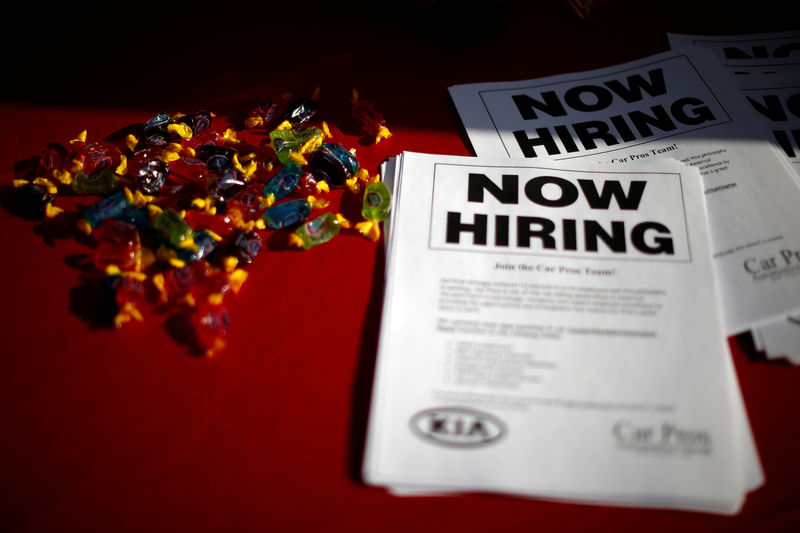By Lucia Mutikani
WASHINGTON (Reuters) - U.S. job growth surged more than expected in June and employers increased hours for workers, signs of labor market strength that could keep the Federal Reserve on course for a third interest rate hike this year despite sluggish wage gains.
Non-farm payrolls jumped by 222,000 jobs last month, driven by hefty gains in healthcare, government, restaurants and professional and business services sectors, the Labor Department said on Friday.
That was the second biggest payrolls increase this year and beat economists' expectations for a 179,000 rise. The economy also created 47,000 more jobs in April and May than previously reported. While the unemployment rate rose to 4.4 percent from a 16-year low of 4.3 percent in May, that was because more people were looking for work, a sign of confidence in the labor market.
"The continued vitality in the U.S. labor market means that the Fed is on track to begin shrinking its balance sheet in September and to raise rates again in December," said Nariman Behravesh, chief economist at IHS Markit in Lexington, Massachusetts.
The jobless rate has dropped four-tenths of a percentage point this year and is near the most recent Fed median forecast for 2017. Though the average workweek increased to 34.5 hours from 34.4 hours in May, wage growth remained stubbornly tepid, putting a wrinkle in the otherwise upbeat employment report.
Average hourly earnings increased four cents, or 0.2 percent, in June after gaining 0.1 percent in May. That lifted the year-on-year wage increase to 2.5 percent from 2.4 percent in May, suggesting some slack still remains in the labor market.
U.S. financial markets shrugged off the anemic wage growth and investors focused on the jump in payrolls, which reinforced views that the economy regained speed in the second quarter after a lackluster performance at the start of the year.
Stocks on Wall Street (SPX) were trading higher and the dollar firmed against a basket of currencies (DXY). Prices for U.S. Treasuries (US10YT=RR) fell.
"The overall takeaway for the growth picture is that the economy seems to have finished the second quarter with decent momentum, and fears of a sharp slowing in the third quarter should be mollified by today's report," said Michael Feroli, an economist at JPMorgan (NYSE:JPM) in New York.
Republican President Donald Trump, who inherited a strong job market from the Obama administration, has pledged to sharply boost economic growth and further strengthen the labor market by slashing taxes and cutting regulation.
But Republicans have struggled with healthcare legislation overhaul and there are worries that political scandals could derail the Trump administration's economic agenda.
WORKER SHORTAGE
There is optimism that the tightening labor market will soon spur faster wage growth amid growing anecdotal evidence of companies struggling to find qualified workers. Some economists, including the Fed, believe that weak productivity is constraining wages.
Others argued soft economic growth last year hurt wages.
"Wage inflation was never going to be a 2017 event. You get paid this year based on how your firm did last year and last year was a slow year for GDP and, more importantly, earnings," said Steven Blitz, chief U.S. economist at TS Lombard in New York. "Wages are accelerating in some industries, just not enough industries to push up the averages."
The Federal Reserve - the U.S. central bank - raised its benchmark overnight interest rate in June for the second time this year.
With inflation, however, retreating further below the Fed's 2 percent target in May, economists expect another rate hike only in December.
They expect an announcement in September on starting to reduce the Fed's $4.2 trillion portfolio of Treasury bonds and mortgage-backed securities.
The economy needs to create 75,000 to 100,000 jobs per month to keep up with growth in the working-age population. The labor force participation rate, or the share of working-age Americans who are employed or at least looking for a job, rose one-tenth of a percentage point to 62.8 percent.
A broad measure of unemployment, which includes people who want to work but have given up searching and those working part-time because they cannot find full-time employment, rose two-tenths of a percentage point to 8.6 percent last month.
This alternative measure of unemployment hit a 9-1/2-year low in May. It has declined eight-tenths of a percentage point this year.
Employment gains were broad in June, with manufacturing payrolls rising 1,000 after factories shed 2,000 jobs in May.
But the automobile sector lost a further 1,300 jobs as slowing sales and bloated inventories forced manufacturers to cut production. The sector has shed jobs for three straight months.
Ford Motor Co (N:F) has announced plans to slash 1,400 salaried jobs in North America and Asia through voluntary early retirement and other financial incentives. Others, like General Motors (N:GM), are embarking on extended summer assembly plant shutdowns, which will leave workers temporarily unemployed.
Construction added another 16,000 jobs last month. Healthcare employment surged by 59,100, while the professional and business services sector created 35,000 jobs. Temporary-help jobs, a harbinger of future hiring, increased by 13,400. Restaurants and bars hired 29,300 workers.
Retailers recruited 8,100 workers, a respite for a sector which had shed jobs for four straight months. Department store operators like J.C. Penney Co Inc (N:JCP), Macy's Inc (N:M) and Abercrombie & Fitch (N:ANF) are struggling with stiff competition from online retailers led by Amazon (O:AMZN).

Government employment rebounded by 35,000 jobs last month, with gains at federal and local governments.